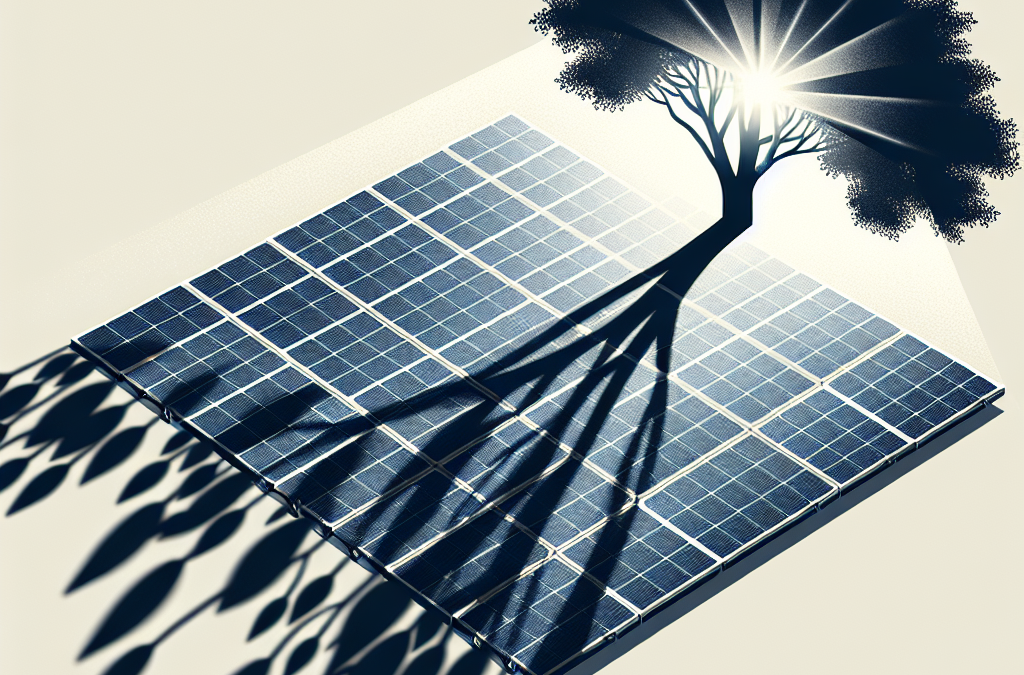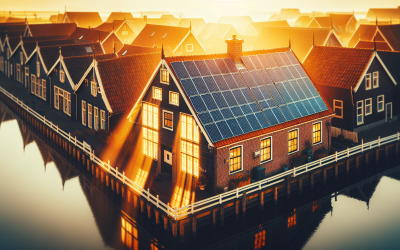Thinking about installing solar panels on your property, but worried about the shade? You’re not alone. Many homeowners wonder if it’s possible to harness the power of the sun when their rooftop is partially blocked by trees, buildings, or other obstructions. The good news is that shade doesn’t have to be a dealbreaker. With advancements in technology and strategies like solar panel positioning, you may still be able to tap into the benefits of solar energy, even in shaded areas. In this article, we’ll explore the possibilities of installing solar panels on shaded properties and discuss some helpful tips to maximize your solar panel’s efficiency.
Assessing Shade Levels
Determining the amount of shade
When assessing shade levels on your property, it’s crucial to determine the amount of shade present. This will help you understand the potential impact on solar panel performance. To assess shade levels, observe your property at different times of the day and throughout the year to account for seasonal variations. Take note of any shadow patterns cast by nearby structures, trees, or vegetation. It’s also helpful to use shading analysis tools or consult with a solar expert to get a more accurate assessment.
Identifying the sources of shade
Once you’ve determined the amount of shade, the next step is to identify the sources of shade. This will help you understand if the shade is temporary or permanent. Common sources of shade include neighboring buildings, trees, and tall structures. Identifying the sources of shade will enable you to develop a strategy to mitigate their impact on solar panel performance.
Factors to Consider
Shade duration throughout the year
Shade duration throughout the year is an important factor to consider when assessing the viability of solar panel installation. If your property experiences prolonged periods of shade throughout the year, it may significantly impact the overall energy output of your solar panels. It’s essential to track the duration and intensity of shade throughout different seasons to evaluate the feasibility of solar installation.
Shade intensity and angle
Apart from the duration, the intensity and angle of shade also play a crucial role in determining the impact on solar panel efficiency. Shadows that completely cover the panels can lead to a significant drop in energy production. Additionally, shade that falls at a steep angle throughout the day may pose a challenge as it can impact the effectiveness of solar panels in capturing sunlight. By considering shade intensity and angle, you can better understand the potential limitations and plan accordingly.
Available space for panel installation
The amount of available space for solar panel installation is a key factor to consider. If your property has limited space and is heavily shaded, it may be challenging to find suitable areas for efficient solar panel placement. Assess the unobstructed spaces, such as rooftops, side yards, or backyards, to determine if they have enough room to accommodate solar panels while minimizing shade interference. Adequate space will ensure optimal solar panel performance and maximize energy generation.
Effects of Shade on Solar Panel Efficiency
How shade affects solar panels
Shade can have a significant impact on solar panel efficiency. When shaded, a solar panel’s ability to convert sunlight into electricity is compromised. This is because solar panels are connected in a series, and if just one panel is shaded, it can affect the entire system’s performance. Shade prevents the shaded panel from producing electricity, which leads to a decrease in the overall output of the entire solar array.
Loss of power output
Shade can cause a substantial loss of power output in solar panels. Even a small amount of shading, such as from a nearby tree branch or chimney, can significantly reduce the efficiency of your solar system. It’s important to note that shade doesn’t just affect the shaded area; it can impact neighboring panels as well. Therefore, it’s crucial to design your solar installation in a way that minimizes shading and ensures maximum energy production.
Heat buildup and potential damage
Shade not only impacts the electrical performance of solar panels but also contributes to heat buildup. When shaded, solar panels are unable to dissipate heat efficiently, which can lead to increased temperatures. Excessive heat can cause long-term damage to the panels, reducing their lifespan and overall efficiency. It’s important to consider the potential for heat buildup when assessing the impact of shade on your solar installation.
Mitigating Shade Effects
Trimming nearby trees and vegetation
One of the most effective ways to mitigate shade effects on your solar panels is by trimming nearby trees and vegetation. By removing or pruning overhanging branches or tall plants, you can significantly reduce the amount of shading your panels receive. However, it’s important to consult with an arborist or tree professional to ensure proper pruning techniques to maintain the health and aesthetics of the trees.
Using shade-tolerant solar panel technologies
Another way to mitigate shade effects is by using shade-tolerant solar panel technologies. Some manufacturers offer solar panels with built-in bypass diodes or microinverters. These technologies help minimize the impact of shading by redirecting the electrical current around shaded cells, ensuring uninterrupted power output. Investing in shade-tolerant solar panel technologies can be a valuable solution for properties with unavoidable shading.
Optimizing panel placement and angle
Proper panel placement and angle optimization can significantly reduce the impact of shade on solar panel efficiency. By strategically positioning your panels away from potential shading sources, such as neighboring buildings or trees, you can maximize their exposure to direct sunlight. Additionally, adjusting the angle of your panels to match the local latitude can ensure optimal absorption of sunlight throughout the day, minimizing the effects of shading on efficiency.
Type of Shaded Areas
Roof shade
Roof shade is a common concern for solar panel installations. If your roof receives significant shade from nearby trees or structures, it is important to assess the potential impact on solar panel performance. In some cases, it may be necessary to trim back or remove trees or consider alternative installation options like ground-mounted systems.
Side yard or backyard shade
Shading in side yards or backyards can also affect solar panel efficiency. If these areas are heavily shaded, it’s important to carefully evaluate whether there is adequate space available for solar panel installation without compromising energy generation. If shaded areas cannot be avoided, alternative solutions such as community solar programs or off-site solar installations may be worth exploring.
Shared property shading
Shared property shading presents unique challenges for solar panel installations. If your property shares a boundary with a neighboring building or tall structure, shading may be unavoidable. In these cases, it’s important to communicate with your neighbors and explore potential solutions together, such as joint trimming of vegetation or collaborative solar panel installations.
Consulting a Professional
Hiring a solar expert
Assessing shade levels and determining the feasibility of solar installation can be complex. Engaging the expertise of a solar professional is highly recommended. Solar experts have the knowledge and experience to evaluate shade levels accurately, assess the impact on solar panel efficiency, and suggest suitable mitigation strategies. They can guide you through the entire process, ensuring you make informed decisions about solar installation on shaded properties.
Requesting shade analysis
If you’re unsure about the extent of shade on your property and the potential impact on solar panel performance, consider requesting a shade analysis. Many solar companies offer this service, which involves a detailed assessment of shade levels using advanced tools and techniques. A shade analysis will provide valuable insights into the best course of action for your solar installation and help you determine if solar panels are a viable option for your shaded property.
Alternative Solutions
Considering ground-mounted systems
If shading on your property is significant and unavoidable, you may want to consider ground-mounted solar panel systems as an alternative solution. Ground-mounted systems allow for greater flexibility in panel placement, ensuring optimal sunlight exposure even in shaded areas. While ground-mounted systems may require additional space, they can be a viable option for properties where roof installations are limited due to shading.
Community solar programs
Community solar programs offer an alternative solution for properties with shading issues. These programs allow individuals to invest in a shared solar project located off-site, which generates electricity that is then distributed to the participants’ properties. By participating in a community solar program, you can still benefit from solar energy without the need for on-site solar panel installation.
Exploring off-site solar installations
If your property is heavily shaded and doesn’t have suitable space for solar panel installation, you can explore off-site solar installations. Off-site solar installations involve leasing or purchasing photovoltaic (PV) systems located elsewhere, such as a solar farm or commercial installation. This allows you to enjoy the benefits of solar energy without the challenges posed by shading on your property.
Permitting and Regulatory Considerations
Local zoning and building codes
Before installing solar panels on your shaded property, it’s crucial to familiarize yourself with the local zoning and building codes. These regulations may have specific requirements or restrictions related to solar panel installations. Understanding and complying with these codes will ensure a smooth and legal installation process.
HOA restrictions
If you live in a community with a homeowners association (HOA), it’s important to review any restrictions or guidelines they have regarding solar panel installations. Some HOAs may have specific rules related to aesthetics, placement, or even shading. Be sure to communicate with your HOA and obtain any necessary approvals before proceeding with your solar installation.
Utility interconnection policies
Utility interconnection policies are another important regulatory consideration. Your utility company may have specific requirements for connecting your solar system to the grid. Understanding these policies and meeting the necessary interconnection standards will ensure that you can take advantage of any available incentives and effectively offset your electricity consumption.
Financial Feasibility
Evaluating the return on investment
Assessing the financial feasibility of installing solar panels on your shaded property is crucial. Consider factors such as the upfront cost of installation, potential savings on electricity bills, available tax credits or incentives, and the estimated return on investment over time. Conduct a thorough evaluation or consult with a solar professional to determine if the financial benefits outweigh the costs, particularly considering the potential shading impact.
Financing options for shaded properties
If shading on your property poses financial challenges for solar installation, explore the various financing options available. Solar loans, leases, power purchase agreements (PPAs), and solar-specific incentives can help make solar panel installations more affordable. Investigate these options and compare them to find the best solution for your shaded property. Additionally, government programs or grants may provide financial assistance for shaded properties, so be sure to explore those opportunities as well.
Conclusion
Determining if solar installation is viable on a shaded property requires careful assessment and consideration of various factors. By assessing shade levels, understanding the effects of shade on solar panel efficiency, and exploring mitigation strategies, you can make an informed decision. Remember to consult with a solar expert, request a shade analysis, and consider alternative solutions if shading is significant. Take into account permitting and regulatory considerations, as well as the financial feasibility of solar panel installation on a shaded property. With the right information and approach, you can determine if solar panels are a practical and beneficial choice for your shaded property.









